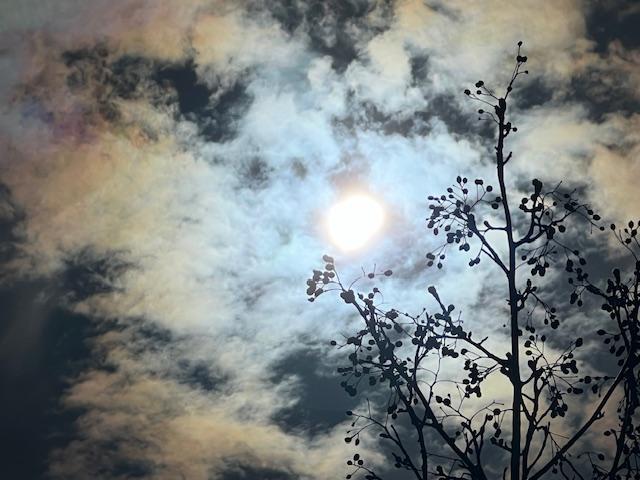
The Solar Eclipse at its full extent from our location in Brooklyn.

Daffodil Hill at its peak of blooming.
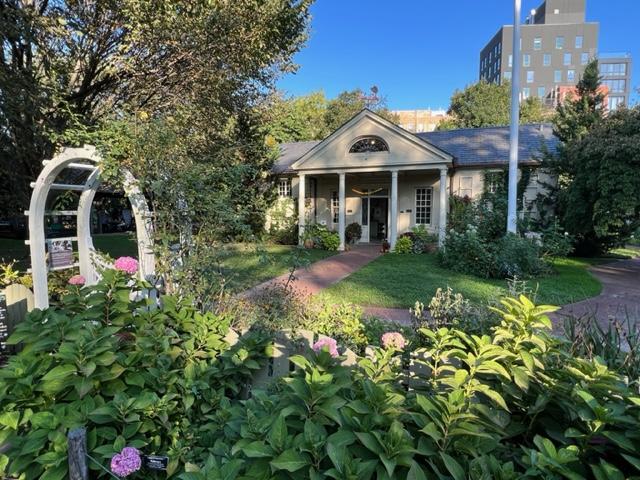
The Children’s Garden in bloom during the Eclipse.
Discovering hidden historical and cultural gems in Manhattan & Beyond
Category: Small Historical Societies in New York City

The Solar Eclipse at its full extent from our location in Brooklyn.

Daffodil Hill at its peak of blooming.

The Children’s Garden in bloom during the Eclipse.

The entrance to the gardens in the Summer of 2022
If you want to see some of the most beautiful sites in New York City during the Spring months when Mother Nature truly works her magic then I would suggest going to the Brooklyn Botanic Garden to see Daffodil Hill and Magnolia Plaza.

The sign when entering Daffodil Hill in the Brooklyn Botanic Gardens
My review on TripAdvisor:
My review on VisitingaMuseum.com:
https://wordpress.com/post/visitingamuseum.com/2785
This is when everything is in full bloom during the early Spring. There is nothing like it and it is so breathtaking with a quiet elegance. On this clear and sunny Thursday afternoon, the gardens were quiet so I had plenty of time to take pictures and enjoy the beautiful views.
I finally got the gardens in the early Spring to see the crocuses, the Snowdrops and the Ironweed flowers that come in the early Spring just as the Daffodils were just coming out. These sensitive flowers are only in bloom a short time and I wanted to see them. They are just beautiful when you see them up close.
The Garden was ablaze with the colors of almost a thousand purple crocuses that lined the hills on the Prospect Park side of the lawns in 2024. Beautiful purple and while colors were in full bloom and Mother Nature shined in the COVID era with all of us socially distanced but still enjoying the park.

Crocus Hills ablaze in purple in 2024

The purple crocuses in full bloom in 2024.

The beautiful purple crocuses in full bloom.
While I was taking pictures of the crocuses, I walked around the gardens and came across the Snowdrops and the Ironweed flowers were also in bloom. These sensitive flowers are only in bloom for just about two weeks. To see them in the gardens in the late Winter is a real treat. They sometimes are in bloom in early and you have to see them quickly before they disappear in the ground.

The Snowdrops in full bloom in the gardens in 2024.

The Snowdrops up close.
The Ironweed just as beautiful. To see these graceful flowers in bloom are a real treat.
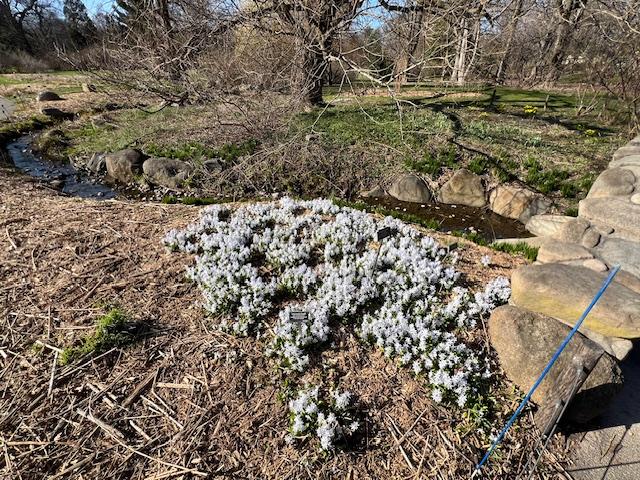
The Ironweed flowers in bloom right by the stream.

The Ironweed flowers in full bloom.

An Azalea that was early blooming in the garden in 2024.

Daffodil Hill at the Brooklyn Botanic Garden
Hundreds of Trumpet Daffodils are in bloom on a hill just off the Japanese Gardens flanked by hundred-year-old trees and it just plays into the backdrop of the greens and browns of the trees and lawns. I can’t tell you on a beautiful sunny day how breathtaking it is just to sit and admire these elegant flowers. It really is a site to see.

Daffodil Hill in full bloom
I love the way these hundreds of flowers make such a beautiful statement and there is such a burst of colors between the yellows and oranges of the daffodil flowers. This only lasts for about two weeks and then the flowers hibernate again.

The side view of Daffodil Hill from the walkway

Daffodil Hill just off the Japanese Gardens
Daffodil Hill is right next to the Magnolia Plaza that was also in peak bloom when I was at the gardens. The trees of the Magnolia Plaza bloom the last week of March and these delicate trees petals do not last more than a week. When I got close enough to them to take pictures, I noticed that some of them were starting to curl already.

The area between Magnolia Plaza and Daffodil Hill
Not all the trees were in bloom yet but these delicate trees are very sensitive to the weather and I have noticed that the petals don’t last as long. Most of the trees were in full bloom but there was not much a smell to the trees. Still everyone was taking pictures in every direction between the Magnolia trees and Daffodil flowers.

The Magnolia Plaza in full bloom

The sign in the Magnolia Plaza

The edge of the Magnolia Plaza

The pathways in the afternoon

The Magnolia trees make such a bold and colorful statement

The array of colors in the Magnolia Plaza

The Magnolia Plaza facing Daffodil Hill in the distance

The Sundial in the middle of the Magnolia Plaza
After taking dozens of pictures of the Magnolia Plaza and Daffodil Hill, I walked over to the Rock Garden. There were not many flowers in bloom there yet as they come out later in the month. There was still an array of daffodils and a few crocuses still in bloom. The Rock Garden was quiet and perfect to walk around in as I had this part of the garden to myself.

The Rock Garden in the early Spring

The Rock Garden in the early afternoon
I headed to the northern part of the garden and visited the Japanese Gardens, where the cherry blooms started to bloom. These graciously landscaped gardens were created in the traditional Japanese form with a combination of trees and shrubs to balance the garden.

Entering the Japanese gardens from the path

The Japanese Gardens pool with traditional buildings

The Japanese Gardens in the early Spring
Returning at the height of the Cherry Blooms was just breathtaking. This view only rivals the beauty of Newark, NJ and Washington DC.

The magnificent Cherry Blossom lawn in April 2024.

People relaxing and enjoying the beautiful afternoon under the Cherry trees.

The beauty of the trees.

The Cherry Blossom at peak form.
Before I left the gardens for the afternoon, I stopped in the gift shop and looked around. They have some wonderful things to buy including a section of Brooklyn made products. There is also an array of plants, books and decorative products to buy.

The Gift Shop at the Brooklyn Botanic Gardens

The Brooklyn made products and book selection at the Brooklyn Botanic Gardens
After my visit to the gardens, I stopped at Bahn Mi Place at 824 Washington Avenue for lunch. I had one of their classic Bahn Mi sandwiches with ham and pate on a chewy hard roll. The food here is consistently good and their sandwiches are excellent.

Bahn Mi Place at 824 Washington Avenue
My review on TripAdvisor:
My review on DiningonaShoeStringinNYC@Wordpress.com:
https://wordpress.com/post/diningonashoestringinnyc.wordpress.com/2187

The Classic Banh Mi sandwich at Banh Mi Place

You have to order the sandwich with a Medium spicy sauce. It adds to the complexity
The sandwiches are excellent. The flavors of the fresh vegetables and meats with the spicy sauce makes complex flavor. The bread is fresh and chewy and don’t be fooled by the size of the sandwich. It is larger than I thought and very filling. See my review on both TripAdvisor and DiningonaShoeStringinNYC@Wordpress.com.
I took my lunch and ate on the steps near the Brooklyn Museum and just enjoyed the afternoon. I people watched and enjoyed the cool, sunny weather. It was nice to escape from classes for a couple of hours and just relax and not think about school or work. It has again become a bit stressful between the two but I will handle everything.
I look forward to this time in the gardens and is one of the reasons why I keep my membership. I love to look at the hundreds of daffodils in bloom and watching as they sway in the wind and just want to look beautiful. It is the most amazing site every Spring.
You do have to time your visits so that you see all these beautiful flowers at each time.
Happy Easter!
Merchant’s House Museum
29 East 4th Street
New York, NY 10003
(212) 777-1089
Open: Sunday 12:00pm-5:00pm/Monday-Wednesday Closed/Thursday-Saturday 12:00pm-5:00pm
Admission: Adults $15.00/Seniors (over 65) and Students $10.00/Members are free/ Special Guided tours are $20.00
My review on TripAdvisor:

The Merchant House at 29 East 4th Street in NoHo

The Historic Plaque

The house is part of the NYCParks system
(from the museum’s pamphlet):
The Merchant House Museum, the former home to four generations of the Treadwell family, was built in 1832 and is designed in the late Federal style of brick and marble. When the house was built, elegant Greek Revival style rowhouses of red brick and white marble flanked the tree lined streets of this fashionable residential enclave, known then as the Bond Street Area.
The house was the home of wealthy merchant, Seabury Tredwell, his family and their four servants. Over the next 98 years, the family lived there and saw the neighborhood and the city grow, change and prosper. In 1936, after the death of the last living relative, the house opened as a museum, complete with Tredwell family’s original furnishings and personal possessions.
At the Midcentury, cast iron made its first appearance and commercial buildings and factories came to dominate the area. By the century’s end, it would be a commercial district with the Tredwell’s being the last holdouts of the area. The house was saved by the last relative’s grand nephew who bought the home to preserve it as a museum.
The home is now part of the NoHo Historic District that includes about 160 buildings, 11 of which are distinguished as individual NYC landmarks
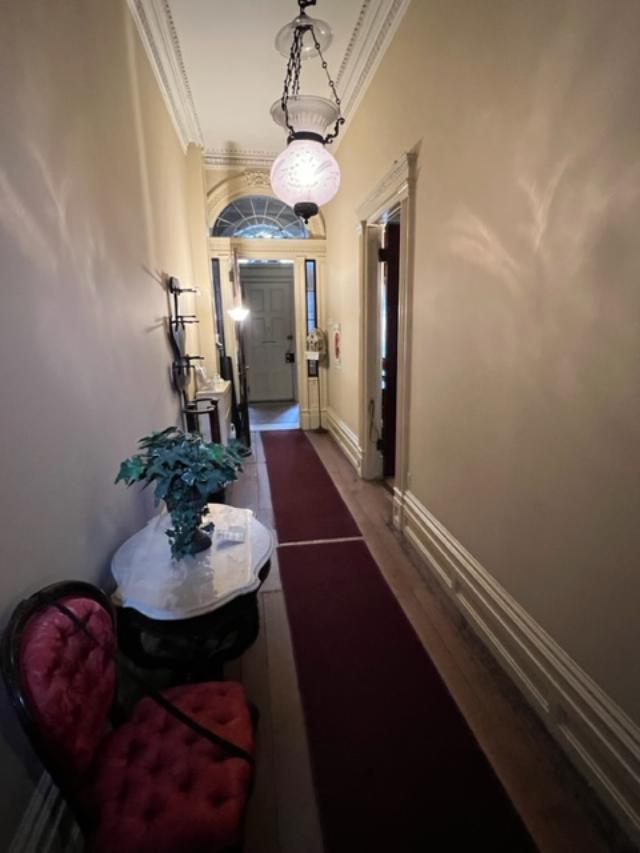
The Entrance Hallway where you would be greeted when you enter the house
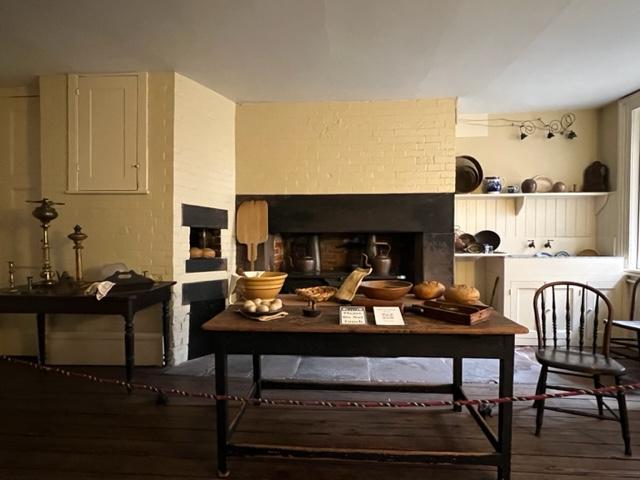
The Merchant House Kitchen ready for dinner to be prepared
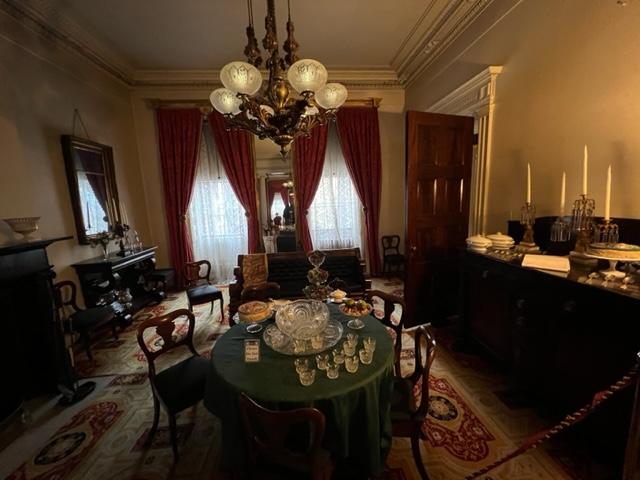
the Dining Room was set for the Dutch New Year gathering
The Christmas holidays were not a big tradition in the early 1830’s when the house was built. The Dutch tradition of visiting on New Year’s Day and making calls to your friends was what many fashionable families would do to socialize with their neighbors. Tea, Coffee and punch would be served along with cakes, sweets and savories. These calls would only last about ten to fifteen minutes before you would move onto the next house. This tradition continued until Victorian times when homes were spread further apart and the family Christmas celebrations with gift giving and a Christmas tree came into fashion due to Queen Victoria and the spread of English and German traditions.

The punchbowl ready for guests on New Year’s Day

Refreshments ready for the New Year’s Day gathering
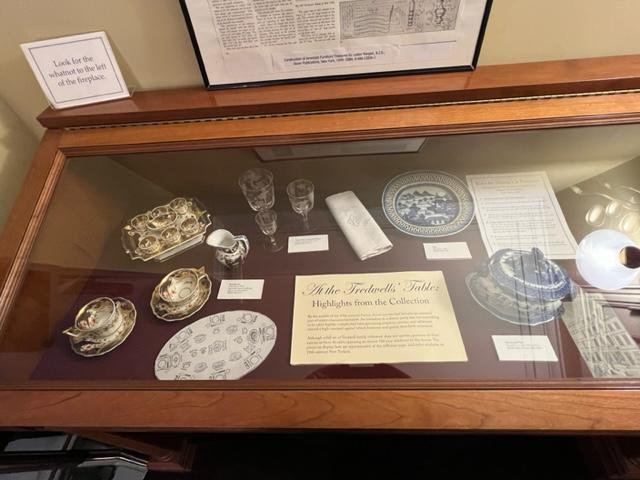
The broken pieces of the china collection of the Treadwell family. There is not a full collection of china that the family had to entertain with for formal affairs. They also did not have any china or silver of the family’s. I think that this might have been passed down to the heirs.

The Parlor of the Merchant House Museum

The piano in the Parlor of the home
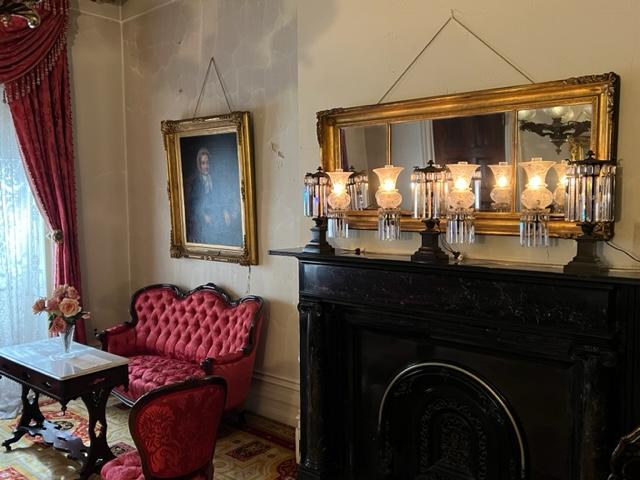
The fireplace in the Parlor
The Parlor is where the family would gather after meals for entertainment and to converse with guests. This would be the main part of the house for socializing as the formal dining room and living rooms would be used for more formal affairs.

The Living Room in the Merchant House
The stairs are rather narrow and steep when you are heading upstairs to the bedrooms so you have to hold on to the rails. The bedrooms are normal size by today’s standards but back then they were pretty big plus people had their own rooms. They were nicely furnished with family heirlooms and antiques.

Mr. Treadwell’s bedroom

The portrait of Mr. Treadwell in his bedroom

Mrs. Treadwell’s bedroom
In Victorian times, the wealthy would have separate bedrooms for the husband and wife. Bedrooms would not just be a place to sleep but they were also a place of business where the family members would do their paperwork, write correspondence and arrange social events. Also, in the case of birthing, the child would be in the bedroom with their mother.

The “Valentine’s Day Card” exhibition “19th Century Valentines: Confections of Affection” on the second floor is part of the house’s extensive collection. ‘Delicate and lacy, these expressions of love celebrate the whimsy and romance of the Golden Age of Valentines’ (from the pamphlet).
The Children’s bedrooms on the third floor were closed off and used as offices for the staff so I made my way up to the Servant’s Quarters on the top floor. These people really got their exercise climbing those stairs up and down every day. The stairs seemed to get more narrow as you headed higher and God forbid there ever be a fire. You would be trapped up there with no way out.
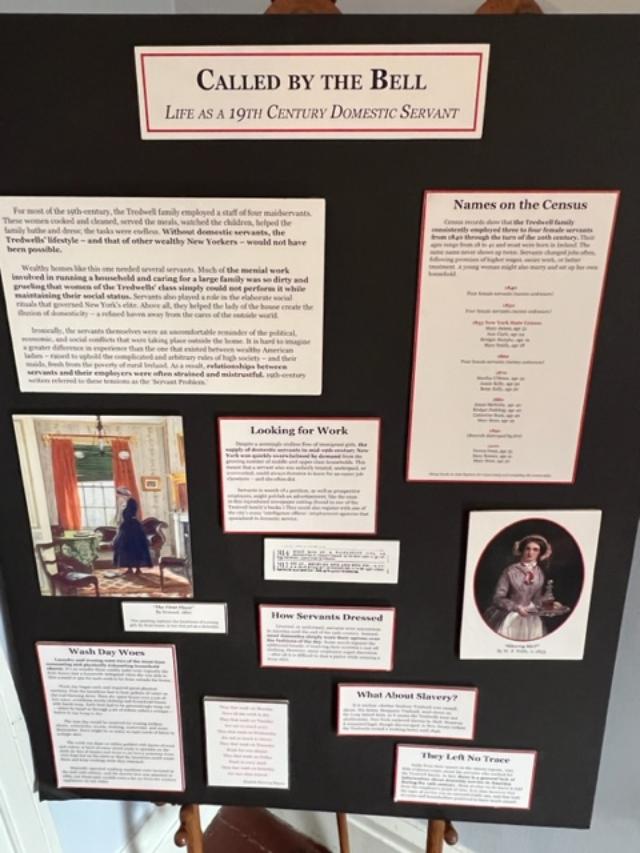
The Servants Room on the fourth floor
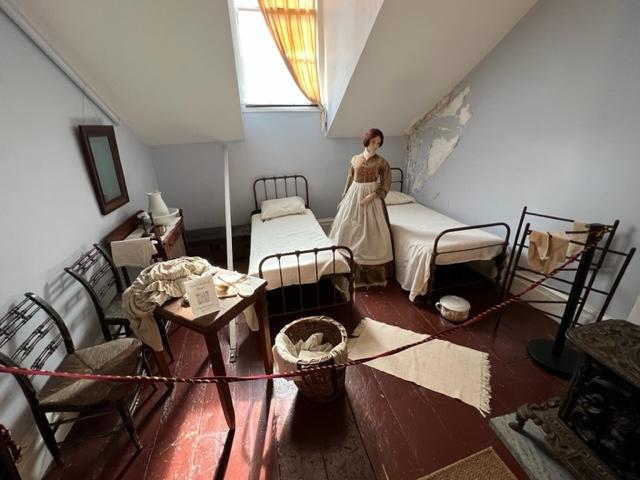
The Servants Room on the fourth floor was pretty spare

Looking for the paranormal

Looking for a ghost on the fourth floor
During October, the museum hosts “Gaslight Ghost Tours”, where you tour the home by candlelight. There have been strange noises in the house ever since Gertrude Tredwell passed in 1934. She had been born in the house in 1840 and lived here until she was 93. She had never married and now it is said that her spirit is still part of the home (museum pamphlet).
After viewing the Servants Quarters and not finding any ghosts, I headed back downstairs to the main hallway leading into the house. There I saw the timeline of the family and all the family members that had lived in the house. It seemed that the last living relative, Gertrude, died in the house in 1934 and her grand-nephew bought the house and all its debts at the height of the Depression to preserve the home as a museum. Talk about insight! The nephew knew how important this home would be one day.
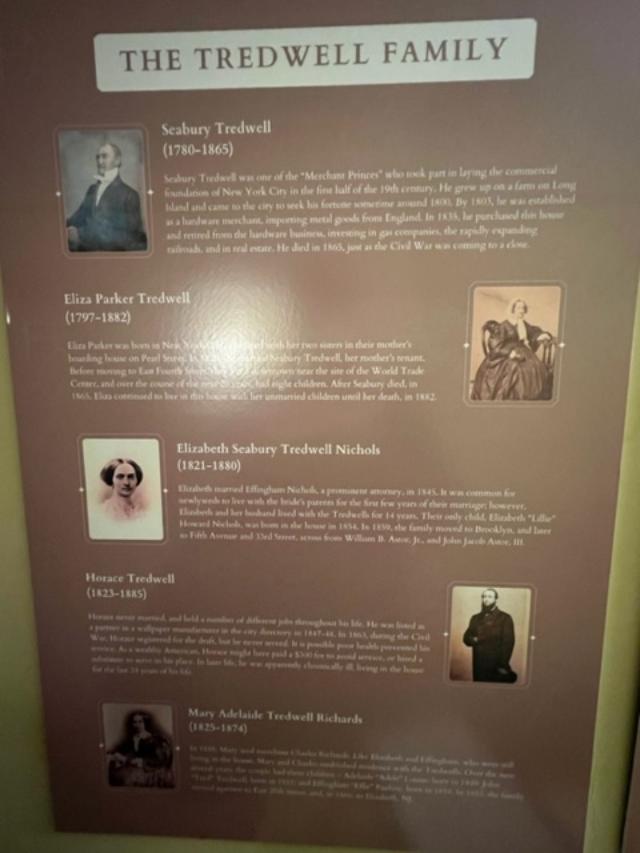
The Treadwell family tree in the hallway downstairs
The last part of the tour was the gardens in the back of the home. It was not a formal yard but a well landscaped walled in garden with a small fountain in the back of the gardens. The flowers were just starting to come up and there were crocuses and daffodils One of the curators was the Master Gardener for the property and did a nice job landscaping the property.

The back of the Merchant House Museum in the late Winter in the Gardens
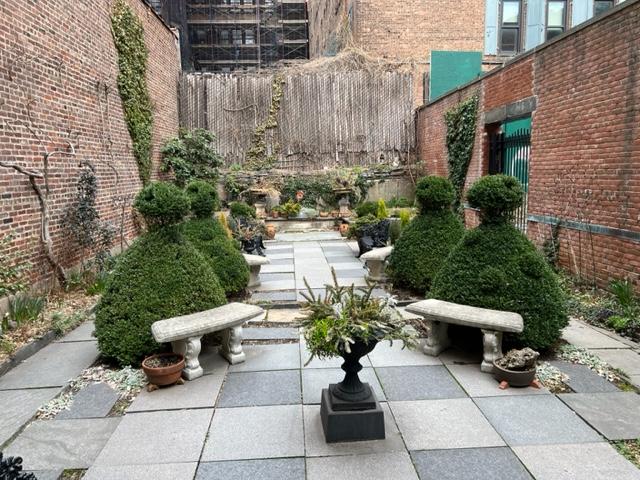
The Gardens of the Treadwell house in the late Winter

The fountain at the gardens was off but now means to come back in the late Spring
There is a more formal tour a couple of times a day of the home but that is by reservation only and there is a separate fee. The holidays offer more themed tours on Halloween and Christmas. The Candlelight tour of the hour for Halloween is really intriguing.

The Merchant House Museum at night before Halloween
I recently went on the Haunted House tour at the Merchants House for Halloween in 2023 and that was interesting. We walked the first two floors of the house in the dark by candlelight hearing stories about the family.
Costumed characters greeted us in every room but none of us saw a ghost. Still the house had a creepy feeling to it as we walked room by room discussing the lives and deaths of the Treadwell family. We started off in the Parlor on the first floor with displays of seances and ghost pictures dotting the displays.

The display of seances and ghost pictures.
It can be a bit spooky walking through a house by flashlight, but the docents made the conversation interesting and fun. We got to hear about all the haunted tales of the house. A highly suggestive tour around Halloween.
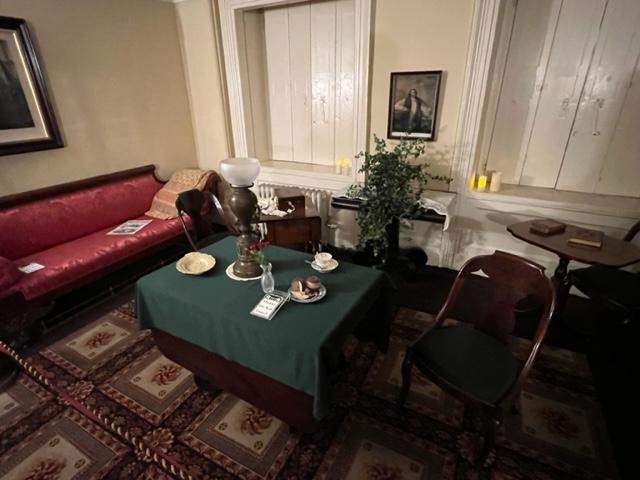
The Parlor at night on the Candlelight tour of the house on Halloween.
The home is very engaging at Christmas time as well as you are welcomed into the Treadwell Home for the Christmas holidays with their annual Christmas Eve Reception and preparations for Christmas lunch. The house was decked out in garland and bows with several Christmas trees in the room. The house was very festive for the holidays and you were welcomed into the world of 19th century New York City at the holidays.
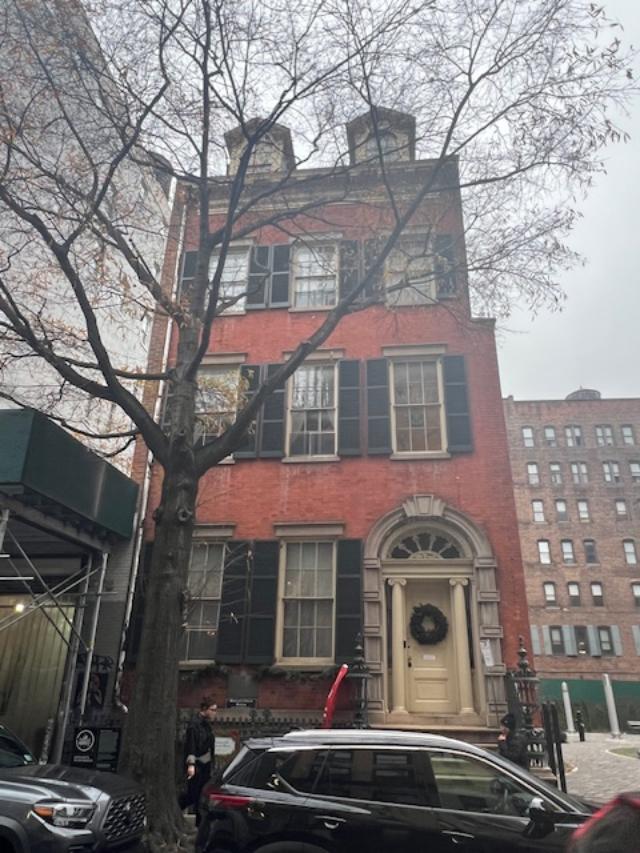
The Merchant House at the Christmas Holidays.

The outside of the house decked out for the holidays.
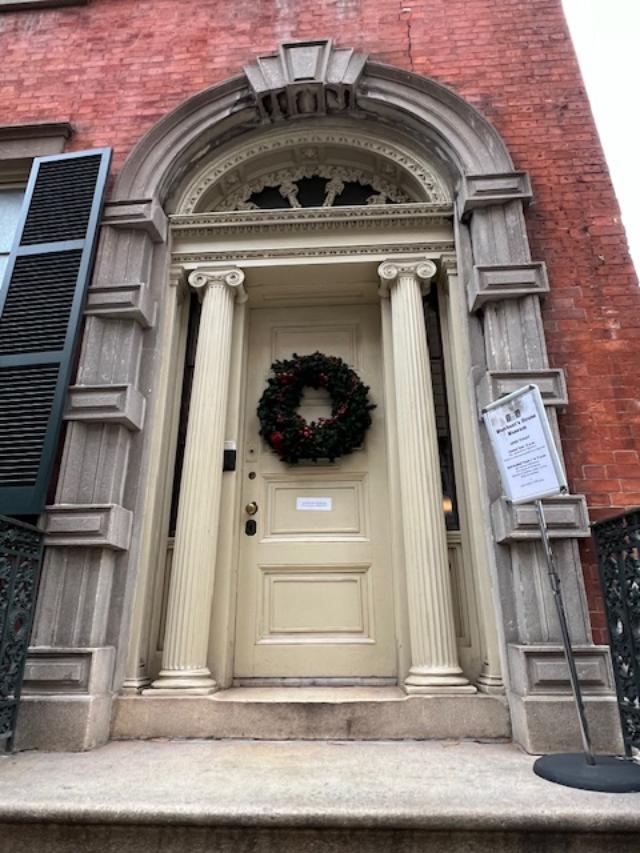
You are welcomed to the home at Christmas time.
We started our tour in the gardens which had gone dormant for the season but still you could see the greens in the bushes and the pine trees. It had been a warm morning in the low 50’s with a treat of rain but later that afternoon. For now, it had just been gloomy. We had a nice conversation about the house and its history even though we could barely hear the tour guide as he talked so softly.
We next toured the kitchen where the cooks were busy cooking and baking for the Christmas holidays. The 19th Century was all about manners, traditions mostly Dutch and entertaining. The Treadwell’s were people who both entertained the neighbors and their family as well. So there would be teas, receptions, open houses and then the formal Christmas Eve festivities and then Christmas lunch after church service the next day.

The holiday meal being cooked in the downstairs kitchen.

Christmas dinner with the Treadwell’s must have been special.
We moved next to the upstairs parlor that was set for receiving guests from the neighborhood. The Treadwell’s like most families at that time received guests for New Year’s Day punch and refreshments as the men of the neighborhood made their social calls during the holiday season. This tradition stopped around the time of the Civil War when families during the Industrial Revolution acquired money and people did not want to ‘entertain just anyone’.
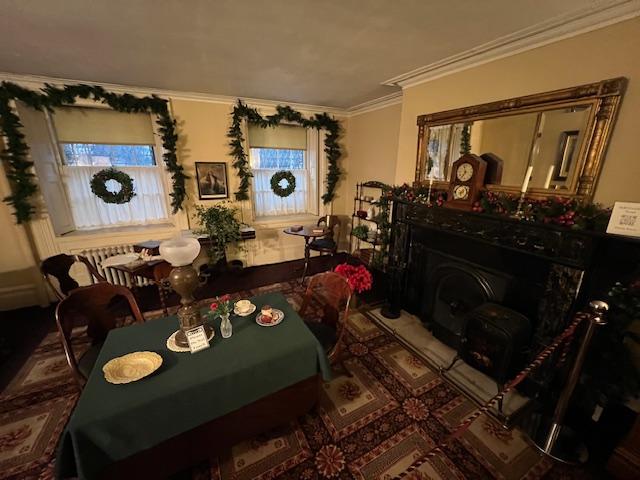
The Parlor by the front door ready to received guests for the holiday season.
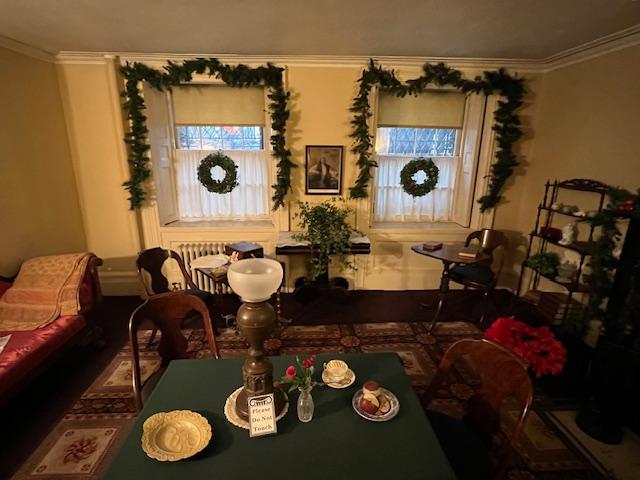
The Parlor on the first floor receiving guests for New Year’s Day.

The mantle was beautifully decorated for the holidays.
We next toured the formal Dining Room and Living Room on the second level where the family entertained relatives and friends for the holidays. It must have been some celebration as the Dutch traditions disappeared and the Victorian rules and elaborate traditions started some still practiced today. Now we call it the “Norman Rockwell” and “Martha Stewart” standards.

The formal Living Room with the Table Tree decorated for the holidays. The Table Tree was the precursor for the modern Christmas tree.

The tree is the focal part of the room.

The fireplace was decked out for the holidays as well.
The Dining Room was set for the Christmas Eve Open House and in preparation for receiving guests in the formal room. The finest silver, china and crystal would have been used to show off the family position in the neighborhood and was meant to impress.

The Dining Room was set for receiving guests for the Open House.
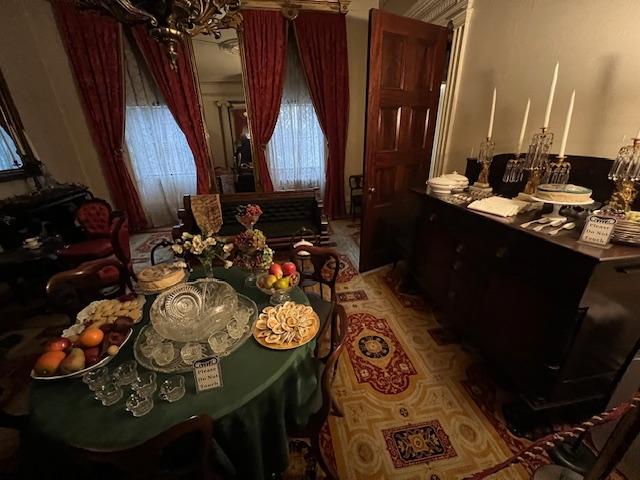
The Dining Room set for a feast.
The family would receive guests all day, replenishing foods so that there was plenty for everyone who visited. Women would be busy all day entertaining neighborhood men who would be calling all day long.

The bannisters were beautifully decorated with garland.

During the Victorian Age gift giving during the holidays became very important.
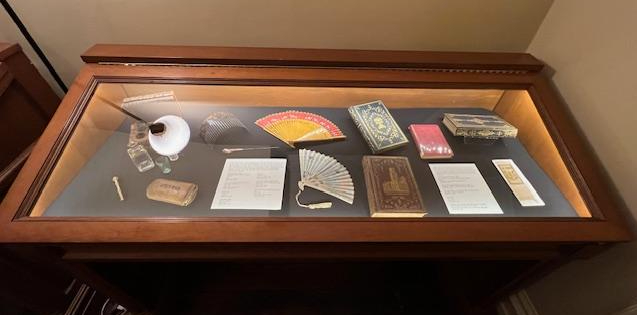
Christmas presents of the Victorian Age.
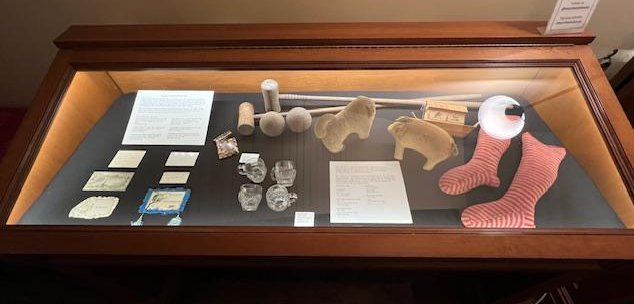
Gifts of the Victorian Age.
We then toured the upstairs bedrooms and saw how they decorated. The rooms were nicely decorated for Christmas. I have never seen rooms decorated like this for the holidays.

Mrs. Treadwell’s bedroom
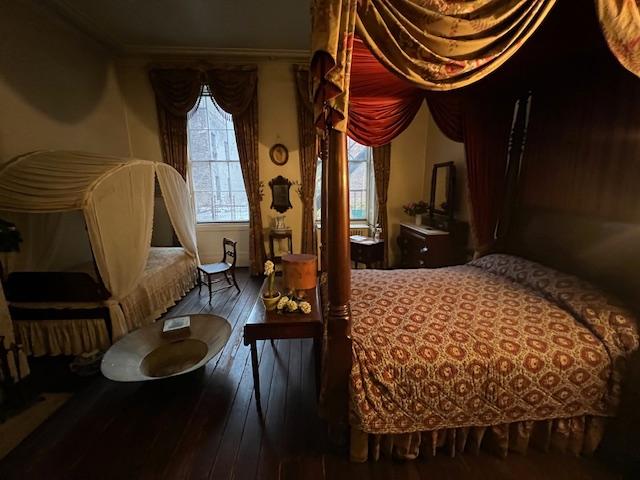
Mrs. Treadwell’s Bedroom

Mr. Treadwell’s bedroom
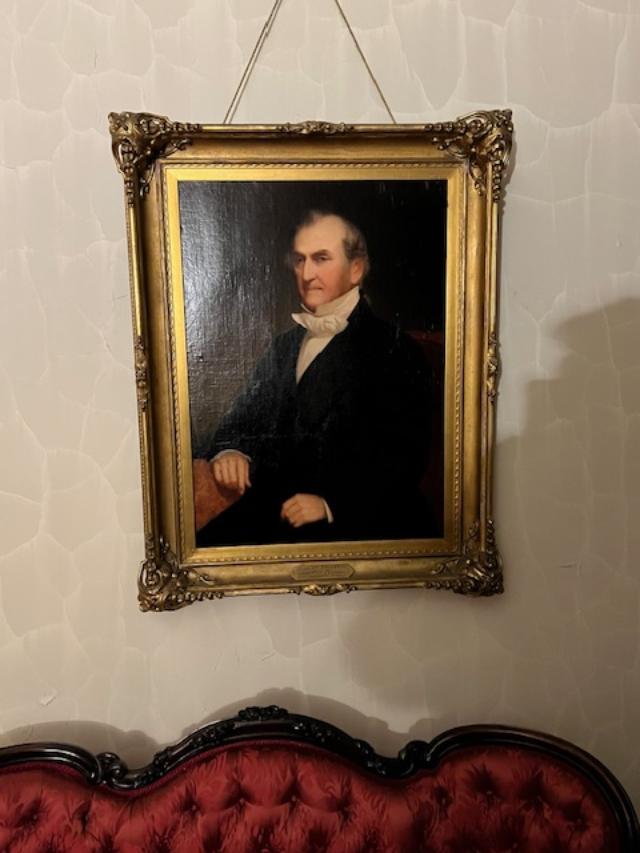
Mr. Treadwell’s portrait in the bedroom standing guard.
It was an interesting look at both Edwardian and Victorian times in New York City.
The museum is currently having a fight to keep construction away from the home. The ten-year battle to keep a hotel from being built has been a problem for the museum. The foundation and structure of the home are in danger due to the fragile state of the building. The Landmark Preservation Commission of New York is researching and looking over the proposal.
The museum is a perfect way to see how residents of a Upper Middle Class family lived in Pre-Victorian times and show the last vestiges of the neighborhood when it was a fashionable section of the City.
Theodore Roosevelt Birthplace National Historic Site
28 East 20th Street
New York, NY 10003
(212) 260-1616
https://www.facebook.com/TheodoreRooseveltBirthplaceNHS
Open: Temporarily closed for renovations
Admission: Free: part of the National Park System
My review on TripAdvisor:

The Theodore Roosevelt Birthplace National Historic Site at 28 East 20th Street
History of the Theodore Roosevelt Birthplace National Historic Site:

From Wiki/National Park Service Pamphlet):
The house is a replica of the birthplace and childhood home of the 26th President of the United States. The house originally stood on the site was built in 1848 and was bought by the Roosevelts in 1854. Theodore Roosevelt was born there on October 27th, 1858 and lived in the house with his family until 1872, when the neighborhood began to become more commercial, and the family moved uptown to 57th Street.

The plaque of the original house
The original home was demolished in 1916 to make way for retail space but upon the death of the President in 1919, the lot was purchased, and the house rebuilt by the Women’s Roosevelt Memorial Association, which eventually merged with the Roosevelt Memorial Association in 1953 to form the Theodore Roosevelt Association. Noted female American architect Theodate Pope Riddle was given the task of reconstructing a replica of the house, as well as designing the museum, situated next door, that serves to complete the site.

Theodore Roosevelt Sr.

Mrs.Alice Roosevelt, Theodore’s mother
The row house next door at number 26, which was the twin to the Roosevelts, was used as a model and some architectural elements from it were incorporated into the replica. The twin house was demolished to make space for the museum. The restoration recreated the house as it was in 1865.
The house is furnished in a mixture of period pieces that would have decorated the house at that time period along with Roosevelt family heirlooms. The was decorated as best as the family at that time could remember. This includes the Living Room, Dining Room, Parlor, the two bedrooms along with the children’s wing. The house had changed over the years so things are not exactly the way they would have been.

The recreation of the Roosevelt Living Room

The Roosevelt Parlor Room

The Roosevelt Dining Room

The Roosevelt Bedroom
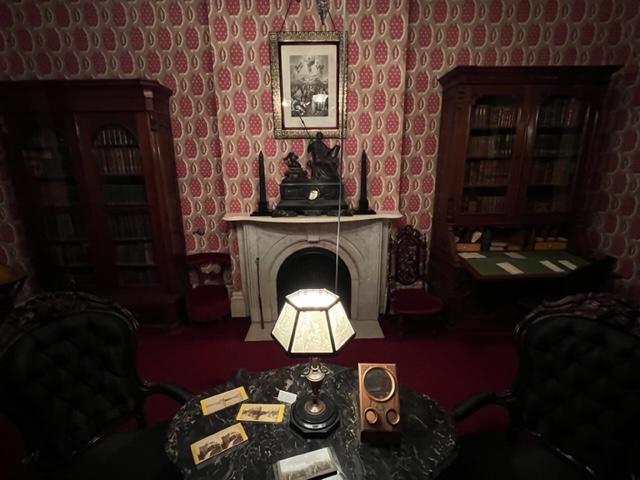
The Roosevelt Library/Office in the bedroom area

The Roosevelt Bedroom
The house was rededicated in 1923 and was subsequently refurbished with many furnishings from the original house by the President’s widow, Edith and his two sisters. The widow and sisters also supplied information about the interior’s appearance during Roosevelt’s residency. The Theodore Roosevelt Association donated the birthplace to the National Park Service in 1963.
The lower level of the house is where the gift shop is located and the gallery room with pictures of President Roosevelt and his family and in government events. They also have the original “Teddy Bear” created for the President and the shirt that the President wore when there was an attempt on his life. There is also a series of family portraits as well.

The “Teddy Bear” is located in the display gallery in the first floor

The shirt the President was wearing when there was an attempt on his life
Try to get to the site during one of the tours and the rangers will give you a detailed talk both on the house and on the family. It is also self-guided so you can take your time to walk the house before it closes for the evening.

The renovation of the house and the displays